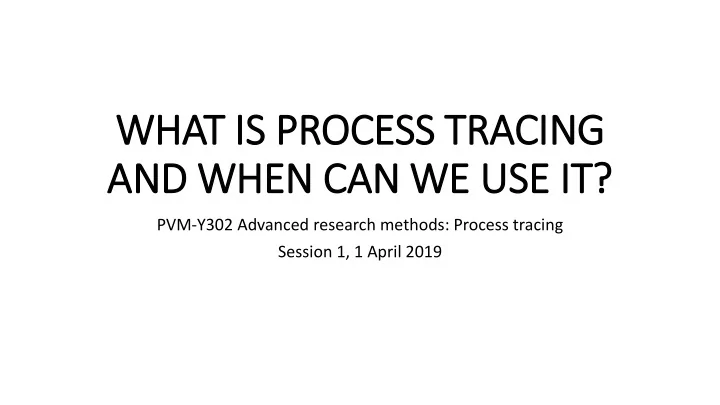

WHAT IS IS PROCESS TRACING AND WHEN CAN WE USE IT IT? PVM-Y302 Advanced research methods: Process tracing Session 1, 1 April 2019
OUTLINE • What is process tracing? • What can we do with it? • Evidence and types of prior knowledge • Variants of process tracing
WHAT IS IS PROCESS TRACING? • ‘Systematic examination of diagnostic evidence selected and analyzed in light of research questions and hypotheses posed by the investigator’ (Beach & Pedersen, 2013) • Qualitative within-case analysis – close engagement with prior knowledge • Goal of analysis: descriptive or explanatory (causal claims) • Empirical observation -> diagnostic evidence • Diagnostic evidence: if mechanism M exists, what observable evidence would it leave in a case?
WHAT CAN WE DO WIT ITH PT? • Describe new political and social phenomena systematically (e.g. color revolutions, the use of social media in political protest) • Hypothesis testing and assessing causal mechanisms • Insight into causal mechanisms • Enrich case knowledge • Use together with quantitative methods to get a more complex picture
TYPES OF PRIOR KNOWLEDGE • Conceptual frameworks - related concepts + ideas about how they can be operationalized • Recurring empirical regularities - established patterns in the relationship of two or more phenomena (‘if a then b’ - causal or descriptive approach) • Theory 1: builds on recurring regularities by connecting them as a set of insights (verified, interconnected hypotheses) • Theory 2: empirical regularities + explanations as to why they occur - this may also be called an explanatory model
VARIANTS OF PROCESS TRACING • Theory-centric: • Theory testing • Theory building • Case-centric: outcome explaining • More common in PT studies
THEORY TESTING PT • Purpose: is a certain causal mechanism present and does it function as theorized? • Starting point: we know where both X and Y are • Outcome of analysis: was the causal mechanism present in a single case? Did it function as expected? • What are we tracing: Single generalizable mechanism • Steps: • Conceptualize causal mechanisms and context • Collect empirical evidence to be used for causal inferences • Update confidence about (partial) presence/absence of predicted mechanism
THEORY BUIL ILDING PT • Purpose: what is the causal mechanism between X and Y? • Starting point: Empirical knowledge that needs structured analysis • Outcome of analysis: Detect plausible hypothetical causal mechanisms about how X is linked to Y • What are we tracing: Single generalizable mechanism • When to use it: • Known correlation between X and Y but no known mechanisms or theory • Known outcome but unclear causes • Steps: • Search empirical material for possible diagnostic evidence of the causal mechanism • Infer evidence from step 1 reflects an underlying causal mechanism • Repeat steps 1-2 as needed
OUTCOME EXPLAINING PT • Purpose: what mechanism accounts for a certain outcome? • Starting point: case knowledge + theoretical background of mechanisms • Outcome of analysis: minimally sufficient explanation (most important aspects with no redundant parts) • What are we tracing: Case-specific (composite) mechanism • Steps: • Determine ‘facts’ of the case (empirical narrative) • Update sufficiency of explanation for outcome • Repeat steps 1-2 as needed
PT VARIANTS: DIF IFFERENCES • Theory-centric or case-centric? • Test or build theorized causal mechanisms? • Focus on systematic mechanisms expected to be present in a population, or case-specific mechanisms? • What types of inferences are made? • Theory testing - about the presence/absence of a mechanism • Explaining outcome - about the sufficiency of the explanation
ROUND-UP UP • PT: qualitative in-case analysis, engage with prior knowledge • Goals: descriptive or causal analysis • Turning observations/prior knowledge into diagnostic evidence • If a mechanism M exists - what observable evidence would it leave in a case? • Variants: theory testing, theory building, outcome explaining
Recommend
More recommend